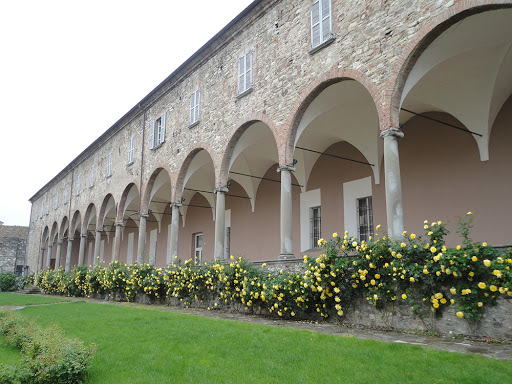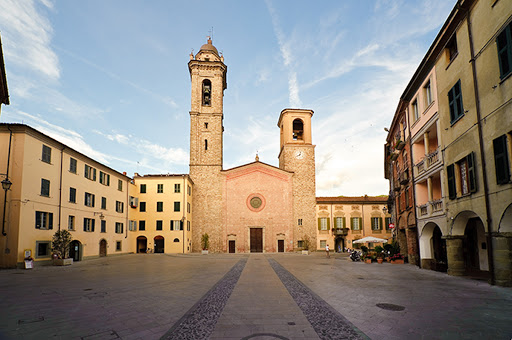In the heart of Val Trebbia, in Emilia Romagna, at the foot of Monte Penice, there is Bobbio, one of the most beautiful medieval villages in Italy. The village rises along the banks of the Trebbia river. Walking through the medieval alleys, you can admire the ancient Ponte Gobbo and the majestic Benedictine Abbey of San Colombano. Bobbio, during the early Middle Ages was the commercial center of the salt road.
Over the centuries it has maintained its historical importance, and today, it is one of the most beautiful villages in Italy as well as a city rich in art and culture.
The origins
The medieval village of Bobbio is located in the province of Piacenza, in the wonderful Val Trebbia which began to be populated during the Neolithic. Around 14 BC the Romans settled permanently in the valley. Subsequently Bobbio became one of the most important centers in Europe when, around 600 AD, the hermit monk Colombano arrived from Ireland and founded a monastery. At the time Bobbio represented the fulcrum of the Via del Sale and the Lombard king Agilulfo entrusted the administration of the city to the Benedictine monk.
And so, walking along the streets of Bobbio, you will discover legends and stories from other times.

WHAT TO SEE IN BOBBIO
ABBEY OF SAN COLOMBANO
It is undoubtedly the most important and significant building in Bobbio. Founded in 614 by San Colombano, the coenoby of the monastery was built on the ancient church of San Pietro, following the architectural dictates of Irish monasteries. Following the death of San Colombano, the monastery was enlarged, first with a Gothic style and then a Renaissance one. It was able to accommodate in 613 AD. about 150 monks, it is not a coincidence that it became one of the most important religious centers in Europe, thanks above all to the scriptorium and the library, where more than 700 manuscripts were kept of which some of the most important Latin ones.
Between the fifteenth and sixteenth centuries, the present monastic complex took shape, which today houses the City Museum, the Abbey Museum and the Basilica. The circular apse, part of the bell tower and the incredible floor mosaic remain of the original Proto-Romantic Basilica.
Do not miss the visit to the Basilica, decorated by Bernardino Lanzani, the crypt, where there is the sarcophagus of San Colombano (dating back to 1480) and the floor mosaic, the only find of the original pavement of the proto-romantic Basilica made with the stones of the Trebbia river. The mosaic depicts scenes from the Old Testament and some scenes from peasant life.

PONTE GOBBO
The Ponte Gobbo is the symbol of Bobbio, also nicknamed Ponte del Diavolo, it is characterized by its asymmetrical profile and by the curved and irregular arches. It is a unique architectural work of its kind and has given rise to numerous legends. The most popular legend has the devil and San Colombano as protagonists. It is said that the devil promised the saint to build the bridge in one night, asking for his soul in exchange. San Colombano accepted and the devil built the bridge in a single night but the following morning, in place of his soul, the Saint handed a little dog to the devil. The devil got very angry and gave the bridge a hard kick, thus making it crooked and lopsided.
The bridge, for several centuries was the only safe connection between Bobbio and the left bank of the Trebbia, as the river often overflowed, preventing crossing.
DUOMO SQUARE
In the center of Bobbio, crowned by arcades, is the main square and the Duomo. The ancient noble palaces and the famous Brugnatelli Palace frame the square and the majestic Duomo.
The Cathedral dates back to the 11th century, although the façade is particularly simple, inside the Cathedral is richly decorated with 15th century frescoes.
From Piazza San Colombano you can reach the fourteenth-century Malaspina-Dal Verme Castle which, with its quadrangular fortification, dominates the village. Alongside the remains of the medieval Torre del Vescovo.
In Duomo square, there is also the Bishop’s Palace, which dates back to the 11th century.

WHAT TO EAT IN BOBBIO
The Bobbiese cuisine is an exquisite mix of Emilian, Lombard and Ligurian cuisine. Among the most famous dishes we mention the macaroni alla Bobbiese, made with the use of a knitting needle (refers to the tool used for crochet) and cooked in a tasty meat sauce, the pretzels, the pine nuts of bobbio with mushroom sauce, stewed snails, or the Bobbiese rice cake with vegetables, rice, eggs and cheese.
As a second course, lamb alla Bobbiese, that is, ribs cooked in broth with salt, garlic and parsley, and side dishes of typical products such as stuffed zucchini, cabbage.
As a dessert we recommend canestrelli, typical biscuits very popular in the Piacenza area.

If you want to spend a weekend in Bobbio, wake up with an amazing view and eat well, contact us!